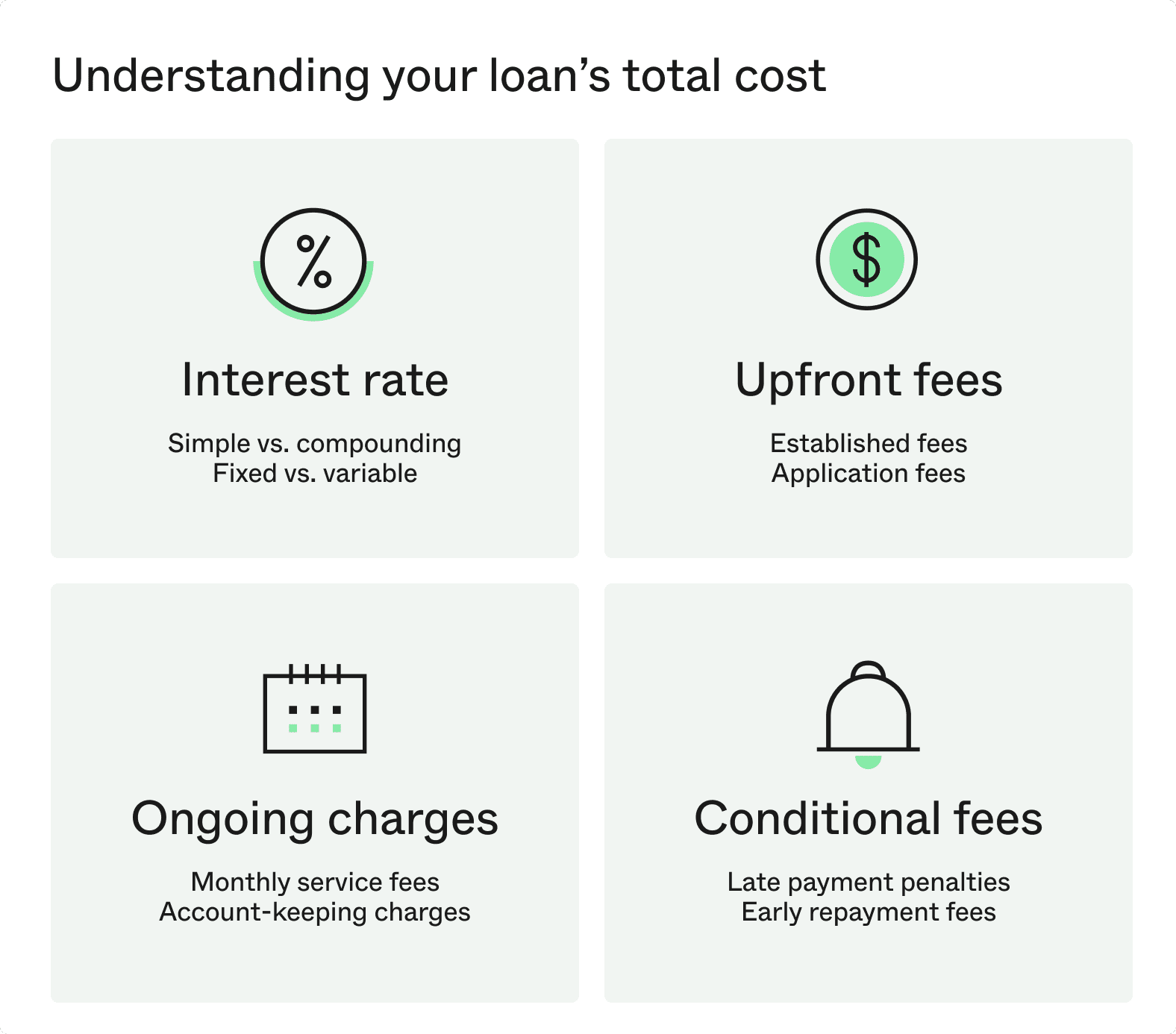This guide breaks down all the fees and charges beyond the interest rate so you can understand the total cost of a business loan in NZ.
At a glance
- To understand the true cost of finance, look beyond the interest rate and account for all establishment fees, ongoing charges, and conditional penalties.
- The total cost is also determined by the loan type, whether it is secured or unsecured, the length of the repayment term, and its structure, either as a one-off loan or a revolving business line of credit.
- Your specific business profile — including your trading history, revenue, and credit score — will also directly influence the rates and terms a lender can offer.
In an era where AI can draft your emails and manage your schedule, you might expect comparing business loans to be just as simple. The reality, however, is that understanding the real cost of finance isn’t as easy as clicking a button. Lenders in New Zealand present their products with different interest rates, fee structures, and repayment terms that can make a true side-by-side comparison challenging if you don’t know what to look for.
This guide is designed to help you break down each component so you can assess the true cost of finance and confidently choose the right funding for your business.
Breaking down the total cost of a business loan
To accurately compare business loans, you need to understand the complete cost of borrowing. This means looking beyond the advertised interest rate to consider all associated fees and charges, so here’s a breakdown of what to look for.
Interest rates explained
The interest rate is the percentage a lender charges on the funded amount, but the calculation method is what matters most. On a $30,000 loan over one year at 15% p.a., for example:
- Simple interest is calculated on the original loan amount. The interest cost would be a straightforward $4,500.
- Compounding interest, calculated on the outstanding balance, would result in a higher total interest cost because you pay interest on the interest.
Many small business loans use simple interest for clarity. It’s also important to know if your rate is fixed (it’s agreed at the start and won’t change for the loan term) or variable (it can change based on market rates). Always ask the lender to confirm the total repayable amount for your exact term so you can compare like-for-like.
A note on terminology in New Zealand: The term ‘comparison rate’ is a consumer-credit concept. Lenders of business loans in New Zealand are not required to display a single, standardised comparison rate. If an Annual Percentage Rate (APR) is provided, treat it as a guide only and base your final decision on the total repayable amount, your repayment schedule, and a full breakdown of all fees.
Upfront fees
Most loans include one-off fees charged at the beginning of the term. Commonly called an establishment, origination or application fee, this covers the lender’s cost of setting up the finance. For example, a 4% origination fee on a $30,000 loan adds $1,200 to the cost. This fee is often added to the total loan balance.
Ongoing charges
Certain products, especially revolving credit facilities, can have regular charges. These might include monthly account-keeping fees or draw-down fees applied each time you use the funds. Such ongoing charges add to the total cost and should be reviewed carefully. The Prospa Business Line of Credit, for example, has a small weekly service fee (calculated as a percentage of your credit limit), which is important to factor into your total cost.
Potential penalty fees
It’s also important to be aware of any conditional fees. Nearly all lenders will charge a fee for late or missed payments. A less obvious cost can be an early repayment fee, which some lenders apply if you pay off a loan ahead of schedule to cover their reduced interest earnings. Prospa does not charge for making extra repayments on your Business Loan or Line of Credit.

A practical example: How the costs add up
To see how these components come together, let’s consider a common scenario. Imagine you run a small cafe and need a $30,000 business loan to purchase a new commercial coffee machine and upgrade your point-of-sale system.
You secure a loan with a 12-month term. Here’s how the total cost could be broken down:
| Loan Component | Amount |
| Initial Loan Amount | $30,000 |
| Approximate Total Interest (15% p.a. simple interest) | $4,500 |
| Origination Fee (4%) | $1,200 |
| Total Repayable Amount | $35,700 |
| True cost of the loan | $5,700 |
In this scenario, the true cost of the loan is $5,700. Looking only at the interest would give you an incomplete picture of what you are agreeing to pay.
Wondering what your repayments could look like? Get an instant estimate with Prospa Business Loan Calculator



How the type of loan you choose affects the cost
The total cost of your finance is also heavily influenced by the product you select. A loan intended for a significant, long-term asset purchase will be structured differently from one designed to manage daily cash flow.
Secured vs. unsecured loan costs
The presence of collateral — a business or personal asset used to secure the loan — is one of the most significant factors that influences an interest rate.
- A secured loan is backed by an asset, like property or valuable equipment. This reduces the lender’s risk, so secured loans generally come with lower interest rates. The new $30,000 coffee machine for our cafe owner, for example, could potentially be used as security.
- An unsecured loan doesn’t require a specific asset as collateral. While this provides more flexibility, the lender takes on more risk, which usually means the interest rates are higher than for a secured loan.
Short-term loans vs. long-term loans
The loan term, or the length of time you have to repay the loan, directly impacts both your regular repayment amount and the total interest you’ll pay.
- A short-term loan, often with a term between 3 and 12 months, is normally used to bridge a temporary cash flow gap or finance a small project. Although the regular repayments are higher, the shorter term means you pay less in total interest.
- A long-term loan, which can have a term of several years, is more suitable for major investments like a major fit-out, expansion, or buying an existing business. The repayments are smaller and easier to manage, but you will pay more in total interest over the full term.
Term loans vs. business lines of credit
The structure of the loan also plays a very important role.
- A term loan gives you a single lump sum of capital upfront, which you then repay in regular instalments over a set period. This is ideal for a specific, one-off purpose, like the cafe’s coffee machine in our example.
- A business line of credit gives you access to a flexible credit facility up to an approved limit. You can draw down funds when you need them and only pay interest on the money you have used. This structure is better for managing ongoing or unexpected expenses, such as fluctuating stock levels or emergency repairs.
For a more detailed comparison, see our guide on choosing between a business loan vs. a business line of credit.
Other business factors that determine your loan costs
Every business has a unique profile, and lenders in New Zealand assess a range of factors to evaluate risk, which in turn influences the rates and terms you may be offered. Your trading history, revenue, credit score, and business structure all play a part.
Loan costs for new businesses (trading 6-12 months)
Lenders look for a consistent record of revenue to prove a business is viable. Because the perceived risk is higher for a newer business, the terms may differ from those offered to a more established company. For a new business with a shorter trading history, this can be a challenge. While some lenders require two years or more of financial records, others specialise in funding newer businesses. Prospa, for example, will lend to businesses that have been trading for 6 months.
The role of your credit score
Your business and personal credit history is a key measure of financial reliability. A strong credit score, built by paying bills and other debts on time, demonstrates to lenders that you are a reliable borrower. While some lenders have rigid credit score requirements, others can look at your score in combination with your business’s real-time performance to get a more complete picture of your financial health. Generally, a stronger credit history will open up access to more favourable rates.
How business revenue affects your options
The amount of revenue your business generates is also important for lenders. Higher, consistent turnover demonstrates a stronger capacity to handle repayments, which can allow you to access larger loan amounts and potentially better terms. Lenders will review your recent sales history to confirm that your cash flow can comfortably support the loan you’re applying for.
Options for self-employed applicants
For sole traders, demonstrating a stable business income can appear more complex than for a company. Lenders understand this and will typically look at a combination of business bank statements and personal tax returns to evaluate the financial health of a self-employed applicant. Keeping your bookkeeping organised and your accounts up to date is the best way to present a strong case for your application.
Understanding ‘no credit check’ and ‘low doc’ loans
It’s important to understand what these common marketing terms actually mean for you.
A low doc loan means the lender may accept alternative documents to verify your financial position, such as business bank statements instead of detailed financial reports.
A ‘no credit check to apply’ offer allows a lender to assess your eligibility using your business’s real-time performance data instead of performing a ‘hard’ credit check that gets recorded on your file. Since multiple hard enquiries in a short time can lower your credit score, these products let you explore your options without any negative impact, which is ideal if you want to compare different lenders or are not yet ready to commit.
Is a faster loan more expensive?
There is a common perception that a more convenient application process must result in a higher cost. However, the cost of a business loan is determined by the lender’s assessment of risk, not by the speed of the application.
The time it takes to get a decision is usually a reflection of a lender’s technology. Traditional lending models often require lengthy paperwork and manual credit assessments, a process that can take weeks. Modern online lenders, however, use technology to securely analyse a business’s real-time financial data. This allows for a much faster credit decision based on an up-to-date picture of your business’s health. With Prospa, for example, you can apply online in minutes and could have funding available in hours.
For a business owner, the more important calculation is often the opportunity cost of waiting. If a slow loan process means you miss a time-sensitive opportunity, such as purchasing discounted stock or securing a new contract, the “cheaper” loan could end up being far more expensive in the long run.




